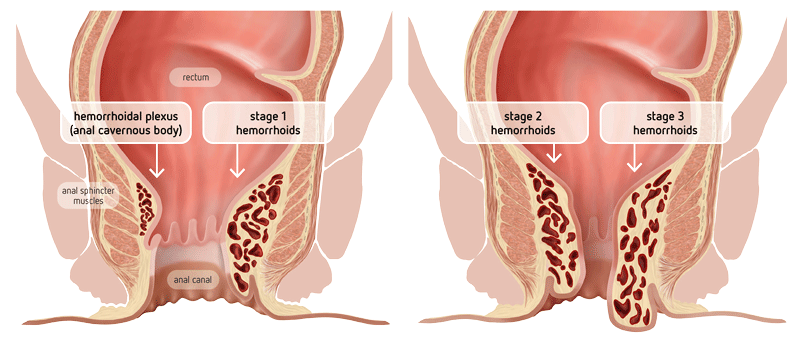
2021/04/23
Large-scale genetic study sheds light on the causes of hemorrhoids (piles)
Hemorrhoidal disease (commonly referred to as hemorrhoids) affects a large portion of the population, for reasons that are mostly unknown. New research from an international collaboration identifies pathophysiological mechanisms by studying the DNA of nearly one million people.
(Bilbao, 23 April 2021). Found at the very end of the digestive tract, hemorrhoids are blood filled cushions that help contain stool and control defecation in humans. Often confusing, hemorrhoids is also what we usually call hemorrhoidal disease (or piles), which is when hemorrhoids swell, causing pain, itching and sometimes bleeding, thus limiting everyday activities. While they mostly remain mild enough to be resolved with over-the-counter treatments, more severe forms of hemorrhoids require surgical treatment associated with considerable disease burden.
Many risk factors have been suggested including a sedentary lifestyle, obesity, reduced dietary fiber intake, spending excess time on the toilet or straining during defecation, strenuous lifting and others, with several being controversially reported. Possibly due to their intimate and embarrassing nature, hemorrhoidal disease has been generally understudied, and neither the exact molecular mechanisms nor the reasons why only some people develop complications are known, hence undocumented theories, myths and hypotheses have become manifest even in the scientific literature.
Research published in the journal Gut now provides important insights, through world-wide collaboration and the analysis of the genetic make-up of almost one million people.
In the new study, coordinated by Prof Andre Franke at IKMB in Kiel Germany and Prof Mauro D’Amato at CIC bioGUNE in Bilbao Spain, researchers looked at millions of DNA changes in the genome of 218,920 patients and 725,213 healthy people from UK Biobank, 23andMe and other population-based cohorts. They identified 102 regions in the human genome that contain genes contributing to increased risk of hemorrhoidal disease. As it turns out from additional analyses in single cells from hemorrhoids, these genes are primarily expressed in blood vessels and gastrointestinal tissues, and collectively involved in controlling smooth muscle function and the development and integrity of epithelial and endothelial structures in the gut. The authors concluded that hemorrhoidal disease results, at least in part, from smooth muscle, epithelial and connective tissue dysfunction. “These are exciting new findings, because they point to specific mechanisms in an otherwise poorly characterized common condition, and this may lead to the development of additional non-invasive therapeutic options in the long run” commented Andre Franke.
When the new genetic information was summarized into polygenic risk scores (PRS), higher PRS were shown to associate with increased risk of hemorrhoidal disease, younger age at diagnosis, and need for surgery in 180,435 additional individuals from the Norwegian HUNT cohort, the Danish Blood Donor Study and a case-control cohort from tertiary centers in Germany. The researchers also reported genetic similarities between hemorrhoidal disease and several other gastrointestinal, psychiatric and cardiovascular conditions, and these showed up as most common comorbidities in further analyses of 8 million people from the Danish National Patient Registry. “Our PRS results require further study in additional cohorts and diverse ethnic groups, but may help to identify people at increased risk of complications who could be more closely monitored and to a greater degree benefit from preventative lifestyles. This could be done in analogy with comorbid and genetically overlapping conditions”, said Mauro D’Amato.
In addition to IKMB and CIC bioGUNE, researchers and clinicians from several other institutions participated in the study, including 23andMe Inc, the Mayo Clinic and the University of Michigan from USA, Monash University in Australia, the Karolinska Institutet in Sweden, the Institute of Genomics, University of Tartu from Estonia, the University of Copenhagen in Denmark, the University Medical Center Rostock in Germany, and others.
Publication
Zheng T, Ellinghaus D, Juzenas S, et al. Genome-wide analysis of 944,133 individuals provides insights into the etiology of hemorrhoidal disease. Gut in press, April 2021
About CIC bioGUNE
The Centre for Cooperative Research in Biosciences (CIC bioGUNE), located in the Bizkaia Technology Park, is a biomedical research organisation conducting cutting-edge research at the interface between structural, molecular and cell biology, with a particular focus on generating knowledge on the molecular bases of disease, for use in the development of new diagnostic methods and advanced therapies. CIC bioGUNE has been accredited as a “Severo Ochoa Centre of Excellence”, the highest level of recognition for centres of excellence in Spain.
About BRTA
The BRTA is an alliance made up of 4 collaborative research centres (CIC bioGUNE, CIC nanoGUNE, CIC biomaGUNE y CIC energiGUNE) and 12 technology centres (Azterlan, Azti, Ceit, Cidetec, Gaiker, Ideko, Ikerlan, Lortek, Neiker, Tecnalia, Tekniker y Vicometch), with the aim of developing advanced technological solutions for Basque companies.
With the support of the Basque Government, the SPRI Group and the Provincial Councils of the three regional provinces, the alliance seeks to promote collaboration among its centres, to strengthen the conditions to generate and transfer knowledge to companies, contributing to their competitiveness, and to spread Basque scientific and technological capacity.
BRTA has a staff of 3,500 professionals, accounts for 22% of the Basque Country’s R&D investment, generates an annual turnover of over EUR 300 million and files 100 European and international patents per year.
About Ikerbasque
Ikerbasque - Basque Foundation for Science- is the result of an initiative by the Department of Education of the Basque Government that aims to reinforce the Basque scientific system through the attraction, recovery and retention of researchers from all around the world. Nowadays, It is a consolidated organization with 290 researchers from from all fields of knowledge.
Photo caption
Figure 1: Alrededor de un millón de muestras de ADN fueron analizadas.
©Oliver Franke, Kiel, Kiel University
Figure 2: Las hemorroides se encuentran antes del ano y estos "cojines" llenos de sangre sirven principalmente como un cierre fino. Las hemorroides agrandadas pueden llegar a ser sintomáticas (etapa II-IV posible), conocida como enfermedad hemorroidal que es muy común en la población. Las hemorroides en estadio II solo pueden reducirse mediante intervención quirúrgica. ©Clemens Franke
See a large version of the first picture

See a large version of the second picture





